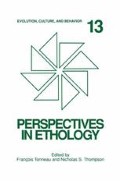Abstract
What do we mean by culture? This question has much in common with some that have been asked in the philosophy of taxonomy. The idea that species are not kinds of organisms, but rather wholes composed of organisms, suggests that cultural units may likewise be wholes made up of parts. If so, they are individuals rather than classes in an ontological sense. There are some very strong analogies between biological species and certain cultural units, especially languages. But there are also important differences, and identifying the wholes and their parts can be difficult. This contribution explores some of the possibilities, especially the relation of compatibility among the parts.
Access this chapter
Tax calculation will be finalised at checkout
Purchases are for personal use only
Preview
Unable to display preview. Download preview PDF.
References
Boyd, R., & Richerson, P. X (1985).Culture and the evolutionary process.Chicago, IL: University of Chicago Press.
Cafagna, A. C. (1960). A formal analysis of definitions of “culture.” In G. E. Dole & R. L. Carneiro (Eds.),Essays in the science of culture in honor of Leslie A. White(pp. 111–132). New York: Thomas Y. Crowell.
D’Andrade, R. (1995).The development of cognitive anthropology.Cambridge, England: Cambridge University Press.
Dupré, J. (1993).The disorder of things: Metaphysical foundations of the disunity of science.Cambridge, MA: Harvard University Press.
Durham, W. H. (1990). Advances in evolutionary culture theory.Annual Review of Anthropology, 19,187–210.
Durham, W. H. (1991).Coevolution: Genes, culture, and human diversity. Stanford, CA: Stanford University Press.
Firth, J. R. (1957). Ethnographic analysis and language with reference to Malinowski’s views. In R. Firth (Ed.),Man and culture: An evaluation of the work of Bronislaw Malinowski(pp. 93–118). London: Routledge & Kegan Paul.
Ghiselin, M. T. (1974a). A radical solution to the species problem.Systematic Zoology, 23, 536–544.
Ghiselin, M. T. (1974b).The economy of nature and the evolution of sex.Berkeley, CA: University of California Press.
Ghiselin, M. T. (1997).Metaphysics and the origin of species. Albany, NY: State University of New York Press.
Heyes, C. M., & Plotkin, H. C. (1989). Replicators and interactors in cultural evolution. In M. Ruse (Ed.),What the philosophy of biology is: Essays dedicated to David Hull(pp. 139–172). Dordrecht, Holland: Kluwer.
Hull, D. L. (1988a). Interactors versus vehicles. In H. C. Plotkin (Ed.),The role of behavior in evolution(pp. 19–50). Cambridge, MA: MIT Press.
Hull, D. L. (1988b).Science as a process: An evolutionary account of the social and conceptual development of science. Chicago, IL: University of Chicago Press.
Keesing, R. M. (1974). Theories of culture.Annual Review of Anthropology, 3, 73–97.
Kluckhohn, C., & Kelly, W. H. (1945). The concept of culture. In R. Linton (Ed.),The science of man in the world crisis(pp. 78–106). New York: Columbia University Press.
Kroeber, A. L., & Kluckhohn, C. (1952).Papers of the Peabody Museum of American Archaeology and Ethnology, Harvard University: Volume 47, No. 1. Culture: A critical review of concepts and definitions.Cambridge, MA: Peabody Museum of American Archaeology and Ethnology, Harvard University.
Landa, J. T. (1994).Trust, ethnicity, and identity.Ann Arbor, MI: University of Michigan Press.
Lumsden, C. J., & Wilson, E. O. (1981).Genes, mind, and culture: The coevolutionary process.Cambridge, MA: Harvard University Press.
Marks, J., & Staski, E. (1988). Individuals and the evolution of biological and cultural systems.Human Evolution, 3,147–161.
O’Hara, R. J. (1996). Trees of history in systematics and philology.Memorie della Società Italiana di Scienze Naturali e del Museo Civico di Storia Naturale di Milano, 22, 81–88.
Plotkin, H. C., & Odling-Smee, F. J. (1981). A multiple-level model of evolution and its implications for sociobiology.Behavioral and Brain Sciences,4,225–235.
Rosenberg, A. (1994).Instrumental biology or the disunity of science.Chicago, IL: University of Chicago Press.
Schleicher, A. (1869).Darwinism tested by the science of language(Transl. Alex. V. W. Bikkers.). London: John Camden Hotten.
Staddon, J. E. R. (1981). On a possible relation between cultural transmission and genetical evolution. In P. P. G. Bateson and P. H. Klopfer (Eds.),Advantages of diversity(Vol. 4, pp. 135–145). New York: Plenum.
Stamos, D. N. (1998). Buffon, Darwin, and the non-individuality of species-a reply to Jean Gayon.Biology and Philosophy, 13, 443–470.
Tylor, E. B. (1871).Primitive culture: Researches into the development of mythology, philosophy, religion, art, and custom(2 Vols.). London: John Murray.
Weiss, G. (1973). A scientific concept of culture.American Anthropologist, 75, 376–413.
White, L. A. (1959). The concept of culture.American Anthropologist, 61, 227–251.
White, L. A. (1975).The concept of cultural systems: A key to understanding tribes and nations.New York: Columbia University Press.
Author information
Authors and Affiliations
Editor information
Editors and Affiliations
Rights and permissions
Copyright information
© 2000 Springer Science+Business Media New York
About this chapter
Cite this chapter
Ghiselin, M.T. (2000). Cultures as Supraorganismal Wholes. In: Tonneau, F., Thompson, N.S. (eds) Perspectives in Ethology. Perspectives in Ethology, vol 13. Springer, Boston, MA. https://doi.org/10.1007/978-1-4615-1221-9_3
Download citation
DOI: https://doi.org/10.1007/978-1-4615-1221-9_3
Publisher Name: Springer, Boston, MA
Print ISBN: 978-1-4613-5447-5
Online ISBN: 978-1-4615-1221-9
eBook Packages: Springer Book Archive

